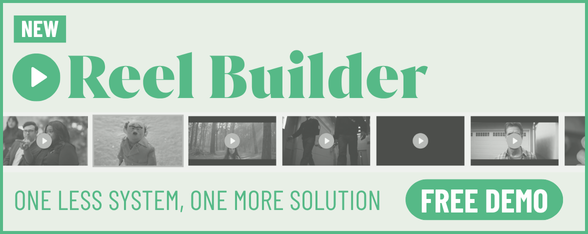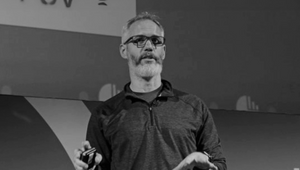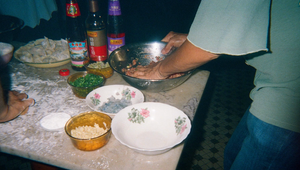
Suzanne Kim on Persimmons, Cars, and the Poetry of Chaos

Suzanne Soo Hyun Kim is a Korean-Australian screenwriter, director and producer based between Sydney and Seoul.
Suzanne’s work holds a primary focus on experimental narrative and delves deep into the heart of the imagination, creating lyrical meditations on life. Her work spans narrative film, commercial and photography. Her ambitious work often contemplates her experience of the Korean diaspora, womanhood, and social impact filmmaking.
Commercially, Suzanne has worked with brands such as Apple, The Guardian, Jordan, and The Sydney Opera House. Most recently she has been featured in a special edition of Vogue Australia magazine guest-curated by Baz Luhrmann as one of the ‘Best in show -- the new class of Australian Female Directors to know’.
Name: Suzanne Kim
Location: Australia and Korea
Repped by/in: Sweetshop Asia
LBB> What are some upcoming projects that you're excited about? Tell us a bit about them?
Suzanne> Right now, I’m in post on a branded documentary short for the new Samsung Galaxy that follows Alice Jun, founder of Hana Makgeolli. It’s a story about solo entrepreneurship, generational legacy, and the everyday technologies that support creative work. What excites me most is that it lives at the intersection of craft and culture, big themes grounded in a very specific human story.
I'm also developing a documentary series that has a focus on Korean home cooks and the stories behind inherited dishes. It’s part portrait, part recipe. It’s intimate, character-driven storytelling about identity and memory through food.
On the narrative side, I’m writing a feature film that explores the complexities of cultural identity for second-generation immigrants, specifically, the challenge of preserving heritage while building new homes. In it, I use persimmons (one of my favourite fruits and one that holds a significant place in Korean history) to serve as both literal and metaphorical vessels for cultural memory representing how traditions and trauma are passed down, often in forms the next generation doesn’t fully understand. It's a personal story with quiet emotional stakes, told through gesture, food, and intergenerational silence.
I’m always excited by work that blurs form, where commercial, documentary, and narrative sensibilities inform each other. These projects feel like extensions of the same impulse -- to hold space for memory, culture, and specificity in how we tell stories.
LBB> What excites you in the advertising industry right now, as a director? Any trends or changes that open new opportunities?
Suzanne> There’s a shift happening: I feel brands are getting more comfortable with nuance. I see more room for tone. Tonal ambiguity, tonal specificity which means directors can create more textured, layered work.
I’m also interested in how advertising is borrowing from indie documentary and genre cinema. It’s less about fitting into a glossy box and more about emotionally precise storytelling, even in short form. The rise of voice, authorship, and hybrid formats excites me. There’s a hunger for a different kind of truth right now and that’s an opportunity.
LBB> What elements of a script sets one apart from the other and what sort of scripts get you excited to shoot them?
Suzanne> I get excited by scripts that know what they’re really about. Not just the product truth but the human truth underneath it. The ones that move beyond a clever premise and let a little tension or contradiction live in the frame. I look for an internal rhythm in a script and how it moves, where it breathes. If it makes me think about how to translate it viscerally, through a cut, a sound, a glance it has me.
LBB> How do you approach creating a treatment for a spot?
Suzanne> I treat the treatment like a short film itself. It should have voice, pacing, and mood. I try to find the cinematic and emotional logic behind every creative choice. I’m not just pitching a look or a tone, I’m offering a directorial mind that can hold the client’s goals and audience attention in the same hand. I like using unexpected visual references and building out a world that feels slightly richer than what’s on the page. It’s about framing, not just how it will look, but why it matters.
LBB> If the script is for a brand that you're not familiar with/ don’t have a big affinity with or a market you're new to, how important is it for you to do research and understand that strategic and contextual side of the ad? If it’s important to you, how do you do it?
Suzanne> It's non-negotiable. I come from a storytelling background, and every story needs context. Understanding the brand’s values, pain points, tone, and competitive space allows me to craft something that’s both creatively strong and strategically sound. I’ll do everything from diving into old campaigns, reading brand decks, to mystery shopping the product. I want to understand the emotional response the brand aims to elicit and then discover a more cinematic or human approach to achieve it.
LBB> For you, what is the most important working relationship for a director to have with another person in making an ad? And why?
Suzanne> The producer. A good, creative, collaborative producer who actually cares about what we’re creating is like a unicorn. A good producer isn’t just about managing logistics; they’re protecting space for creativity. I need a producer who knows how to keep the machine running while also helping to preserve the intention behind every creative decision. It’s a left brain/right brain dance. When that relationship works, you feel invincible.
LBB> What type of work are you most passionate about - is there a particular genre or subject matter or style you are most drawn to?
Suzanne> I’m drawn to work that has duality, beautiful and uncomfortable, tender and tense. Whether it’s a sports piece, docu-style piece, or narrative spot, I love anything that lets me play with emotional specificity and visual rhythm. I’m especially drawn to underrepresented perspectives and non-linear storytelling, anything that lets me shape time and texture in a way that feels a bit off-centre, but emotionally true.
I’m also fascinated by the psychology of sport and cars. Specifically, the ritual, the repetition, the way both bodies and machines move under pressure. There’s something cinematic about watching control meet chaos. For me, sport is the perfect metaphor for life: it’s where discipline, failure, ego, pain, and transcendence collide in real time. I’m interested in the emotional architecture behind performance and velocity and how movement becomes a language of its own, revealing what people believe about themselves.
LBB> What misconception about you or your work do you most often encounter and why is it wrong?
Suzanne> That my work is “quiet.” It’s not quiet. It’s just not loud for the sake of being loud. I like stillness, I like interiority, but there’s always an emotional architecture underneath. People sometimes mistake minimalism for passivity. But when used right, restraint is power. And it invites the audience to lean in.
LBB> Have you ever worked with a cost consultant and if so how have your experiences been?
Suzanne> Yes, and I think when it’s done right, it can actually be liberating. Constraints force clarity. Working with a cost consultant is less about “cutting” and more about asking the right questions: what’s essential, what supports the idea, what is just a habit. I find that it pushes me and my team to be more inventive, and sometimes it leads to sharper visual ideas.
LBB> What’s the craziest problem you’ve come across in the course of a production -- and how did you solve it?
Suzanne> On one shoot, our location flooded the day before we were set to film and it wasn’t the kind of spot you could just move. We pivoted by rewriting key blocking to fit a partially closed set, shifted coverage to make it feel intentional, and incorporated the unexpected water element as part of the visual metaphor. The agency was nervous, but once they saw the first few shots, they got on board. Sometimes chaos forces you to lean into poetry and what the film Gods offer up.
LBB> How do you strike the balance between being open/collaborative with the agency and brand client while also protecting the idea?
Suzanne> I always assume everyone is there because they care. I listen deeply to what’s said, and what’s not said. Then I ask myself: what’s the spine of this idea? What can flex, and what breaks it? Collaboration works best when people feel heard, and when you’re confident enough to say, “Here’s why I’d fight for this choice, and here’s another way we could get the same result without compromising the story.” That builds trust.
LBB> What are your thoughts on opening up the production world to a more diverse pool of talent? Are you open to mentoring and apprenticeships on set?
Suzanne> Absolutely. There’s so much unspoken language on set, and access is the only way people can learn it. I’ve benefited from generous mentors and I’m always looking to pay that forward especially to women, queer talent, and BIPOC voices trying to break into commercial directing or department work. If someone shows up prepared, curious, and ready to learn, I will always make space.
LBB> Your work is now presented in so many different formats - to what extent do you keep each in mind while you're working (and, equally, to what degree is it possible to do so)?
Suzanne> I think about format early, but not first. I focus on the core emotion and visual structure first then make sure it adapts well across formats. You can’t shoot like it’s cinema and just crop later. I often plan alternate framings or moments that translate to vertical/social without diluting the main idea. Each format has a different tempo and knowing how to recalibrate rhythm is as important as reframing.
LBB> What’s your relationship with new technology and, if at all, how do you incorporate future-facing tech into your work?
Suzanne> I use tech to support storytelling not to distract from it. I’m excited by AI-assisted workflows for previsualisation, interactive formats that allow for multiple POVs, and using data to inform narrative shape in real time. But I always ask: what emotional or creative problem is this solving? If the answer is clear, I’ll embrace it. If not, it’s noise.
LBB> Which pieces of your work do you feel show what you do best – and why?
Suzanne> Ford – 'Live Curious' (Commercial Spot) – In "Live Curious," curiosity becomes a cinematic adventure. The commercial unfolds in reverse following a group of friends retracing steps back to the spark of exploration. Every shot subtly reveals hidden Easter eggs that coax the viewer deeper into the story, mirroring the act of discovery itself. This spot let me lean fully into visual storytelling rooted in narrative structure blending reverse chronology with emotionally resonant visuals to highlight both the versatility of the Ford Explorer and the universal impulse to explore.
Hyundai – Smart City (Brand Film) – A speculative look at how smart cities might evolve, this piece blends documentary realism with future-facing visual design. It was an opportunity to bring nuance to a tech-forward brief, grounding innovation in human stories and daily rituals. It reflects my approach to translating abstract ideas into relatable, tangible imagery.
JW Marriott – 'Stay in the Moment' (Campaign Film) – This Asia-Pacific campaign film, featuring Korean actor Lee Min-ho and set in elegant JW Marriott properties, unfolds like a K-drama. It portrays a family reconnecting through mindful moments framed in lush, contemplative visuals. By marrying cinematic intimacy with brand storytelling, I helped craft a visual tone that feels both luxurious and emotionally grounded, inviting viewers to pause and be present.
Running Bare - 'This One’s For Me' + 'Push Beyond' – Visually visceral series about the line between body and performance. Bold use of colour, fragmented editing, and textural sound design.
Westfund – 'Out Here' – A brand campaign that reimagines health insurance through regional, community-rooted storytelling. We showcased everyday people from rural landscapes living wholesome, mental-health oriented lives. The campaign reframed Westfund not simply as a policy provider, but as a philosophy: “health insurance from a healthier place,” rooted in values of trust, community, and generational values.
Night Bloomers – Narrative Anthology Series (SBS Australia, Premiered at SXSW Sydney) -- A genre-bending series exploring Korean myth and diaspora identity through horror, surrealism, and speculative storytelling. Each episode stands alone but shares a common thread: the psychological experience of being caught between worlds. This project allowed me to build distinct visual and sonic textures for each story, and fully lean into nonlinear, emotionally driven storytelling.















